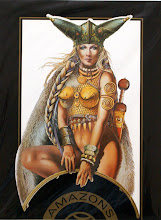Charles Edmund Brock was a member of a distinguished family of artists. He was the eldest son of Edmund Brock, a scholar of medieval and oriental languages and a reader at the Cambridge University Press. Edmund, born in 1840 in Shepreth, Cambridgeshire, was also the son of a painter, Jeremiah Brock. Moving to London, Edmund worked as a bookmaker in his early career. He married Mary Ann Louise Pegram in 1867 and the first of seven children, Alice Emma, was born the following year.
Charles Edmund followed on 5 February 1870, born in Upper Holloway. He grew up in London and St Andrew the Less, Cambridge, where his family moved in the 1870s. Here he studied at the Higher Grade School and in the studio of Cambridge sculptor Henry Wiles.
Brock began his illustrative career working for a number of different publishers. For George Routledge & Sons he illustrated The Parachute by J. R. Johnson (1891); and for Tyneside publisher Walter Scott he illustrated The Humour of Germany (1892) and The Humour of America (1893) in wash. But it was as an illustrator for the Cranford series published by Macmillan that he first came to public attention. Charles -- who dropped his middle name when signing his work -- produced 130 black & white illustrations for Thomas Hood's Humorous Poems (1893) and 100 for an edition of Jonathan Swift's Gulliver's Travels (1894). In 1895, Brock illustrated Annals of the Parish by John Galt and Pride and Prejudice by Jane Austin, but his major achievement was for the two-volume Macmillan edition of Charles Kingsley's Westward Ho! (1896).
At the same time he was producing illustrations for The Sunday Magazine and Good Words, and was now in great demand. For Service and Paton he illustrated Ivanhoe in 1897, followed by The Lady of the Lake (1898), The Life and Adventures of Robinson Crusoe (1898) and The Vicar of Wakefield (1898).
Charles's career was followed closely by that of his younger brother, Henry Matthew Brock, who also illustrated books for Macmillan and Service & Paton's English Illustrated Novels series. The two shared a studio with a third brother, Richard Henry Brock, and Charles and Harry's mutual fascination with furniture and costumes of the 18th and early 19th century meant that they filled the studio with artefacts and reference material.
The two began working for J. M. Dent in the late 1890s, producing illustrations for editions of Jane Austin's novels. Charles also contributed pen & ink drawings to two volumes of Charles Lamb's The Essays of Elia (1900) and watercolour illustrations to Dent's English Idylls series (1904-09).
Writing in the Dictionary of National Biography, Ian Rogerson expresses the opinion that "Because of their versatility and willingness to take on such a wide variety of work, it is believed that the Brocks did not command the same respect publishers accorded Arthur Rackham and Edmund Dulac, who were much less prolific. As a result, they did not have the opportunity to work on lavish picture books issued by such publishers as Heinemann and Hodder and Stoughton between the turn of the century and 1914. Charles's best opportunity was to contribute coloured illustrations for Sampson Low's boxed, limited issues of Blackmore's Lorna Doone (1910) and three of Jeffrey Farnol's popular historical novels." Charles's association with Farnol, for whom he produced a great many book jackets, would continue until his death.
Illustrations in books suffered during the depressed 1920s and 1930s, but Charles continued to find work, including a series of Dickens's works, Pickwick Papers, Christmas Tales, Nicholas Nickleby and Martin Chuzzlewit (1930-32), The Heroes of Asgard by Annie & Eliza Keary (1930) and The Cuckoo Clock by Mrs. Molesworth (1931). He also worked for periodicals, including Punch, The Strand, The Graphic and The Captain.
Charles exhibited at the Royal Academy and at the Royal Institute of Painters in Water Colour, as did Harry and Richard, and was elected a member of the Royal Institute in 1908.
Charles was married to Annie Dudley Smith in 1902. He died at his home, Cranford, 38 Grange Road, Cambridge, on 28 February 1938, aged 68.
Examples of Charles Edmund Brock's artwork can be found for sale at the Illustration Art Gallery.
Subscribe to:
Post Comments (Atom)






















No comments:
Post a Comment